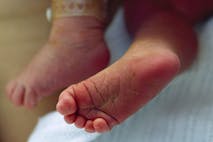
VA school district claims it didn't take students for abortions, puts whistleblower on leave
Cassy Cooke
·We are urgently seeking 500 new Life Defenders (monthly supporters) before the end of October to help save babies from abortion 365 days a year. Your first gift as a Life Defender today will be DOUBLED. Click here to make your monthly commitment.

International·By Bettina di Fiore
Report: UK abortionists are grossly underreporting abortion complications
A new report released by the United Kingdom’s Office for Health Improvement and Disparities (OHID) reveals that abortion complications in England are very likely being underreported by abortionists.
The report compared English Hospital Episode Statistics (HES) data (which is derived from hospital admissions due to abortion complications) to Abortion Notification System (ANS) data (which is supplied by abortionists), for the years 2017 through 2021.
Abortionists in the UK are required to submit a document called an HSA4 form to the Chief Medical Officer at the Department of Health and Social Care for every abortion they commit. In addition to other information, this form documents complications that occur up to the time of discharge; they do not document complications that might occur after women leave abortion facilities. They also do not document complications experienced by women receiving the abortion pill by mail. What’s more, according to the report, there was “no evidence” that abortionists were updating HSA4 forms after their initial submission, even if abortionists became aware of post-discharge complications.
ANS data is derived from HSA4 forms, and this data has formed the basis for the nation’s official annual abortion statistics. The OHID report, however, suggests that these official statistics are grossly inaccurate.
ANS-derived data shows an average complication rate of 1.52 per 1,000 abortions for the years 2017-2021. However, HES data shows an average complication rate of 4.06 per 1,000 abortions for the same period; this rate is nearly 2.7 times higher than the rate derived from ANS data.
Neither ANS nor HES data normally define incomplete abortions as a “complication”; when these are included in the HES data, the complication rate jumps to 18.16 per 1,000 abortions committed. This is nearly 12 times higher than the ANS-based complication rate.

HES-derived data shows that the highest complication rate during the five-year period occurred during 2021, the year after at-home abortions using the so-called “no-test protocol” became legal in the UK. The HES-derived complication rate for 2021 is 4.4 per 1,000 abortions; when incomplete abortions are included, the rate increases to 19.3.
Dear Reader,
Every day in America, more than 2,800 preborn babies lose their lives to abortion.
That number should break our hearts and move us to action.
Ending this tragedy requires daily commitment from people like you who refuse to stay silent.
Millions read Live Action News each month — imagine the impact if each of us took a stand for life 365 days a year.
Right now, we’re urgently seeking 500 new Life Defenders (monthly donors) to join us before the end of October. And thanks to a generous $250,000 matching grant, your first monthly gift will be DOUBLED to help save lives and build a culture that protects the preborn.
Will you become one of the 500 today? Click here now to become a Live Action Life Defender and have your first gift doubled.
Together, we can end abortion and create a future where every child is cherished and every mother is supported.
This should perhaps be unsurprising, because the “no-test protocol” omits screenings for gestational age and ectopic pregnancy, among other things. Consequently, women well past the first trimester have been given the abortion pill in the UK, including one woman who was between 32 and 34 weeks gestation.
It has been consistently shown that the abortion pill becomes less effective and more dangerous as the gestational age of the child increases. ANS data included in the OHID report verifies this. When compared to those committed at between 2 and 9 weeks gestation, the complication rate for abortions committed by pill between 10 and 12 weeks gestation is 18.33 times higher; the complication rate for abortions committed by pill between 13 and 19 weeks gestation was 110 times higher; and at 20 weeks gestation or more, the complication rate was over 160 times higher. These numbers do not include incomplete abortion.
Because of the inaccurate nature of official UK abortion complications statistics, which are based solely on ANS data, and because of the dramatic increase in risk when the abortion pill is used at later gestational ages, UK-based pro-life advocates are calling for an end to at-home abortion and reforms in complication reporting methods.
Catherine Robinson, spokesperson for Right to Life UK, said: “We are calling on the Government to urgently introduce new measures to ensure that abortion complications data is accurately collected and reliably reported on.” She further called upon the government to “heed calls to reinstate in-person appointments before all abortions take place to ensure that the gestation of babies can accurately be assessed, given that the abortion provider, the British Pregnancy Advisory Service, sent out abortion pills to a woman whose baby, Lily, was at least 32 weeks gestation, and given the fact that this does not appear to be an isolated case.”
Robinson added: “It is likely that these cases would not have happened had the gestation of the babies been accurately identified by ultrasound or a physical examination during an in-person appointment.”
Live Action News is pro-life news and commentary from a pro-life perspective.
Contact editor@liveaction.org for questions, corrections, or if you are seeking permission to reprint any Live Action News content.
Guest Articles: To submit a guest article to Live Action News, email editor@liveaction.org with an attached Word document of 800-1000 words. Please also attach any photos relevant to your submission if applicable. If your submission is accepted for publication, you will be notified within three weeks. Guest articles are not compensated (see our Open License Agreement). Thank you for your interest in Live Action News!

Cassy Cooke
·
International
Bridget Bosco
·
International
Nancy Flanders
·
International
Angeline Tan
·
International
Leslie Wolfgang
·
International
Nancy Flanders
·
International
Bettina di Fiore
·
Human Rights
Bettina di Fiore
·
Politics
Bettina di Fiore
·
Human Interest
Bettina di Fiore
·
Activism
Bettina di Fiore
·